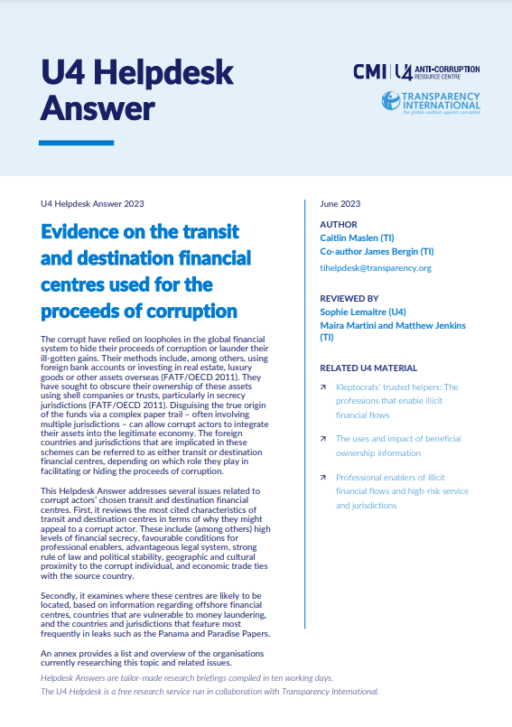- Home
- Anti-Corruption Helpdesk
- Evidence on the transit and destination financial centres used for the proceeds of corruption
Evidence on the transit and destination financial centres used for the proceeds of corruption

This Anti-Corruption Helpdesk brief was produced in response to a query from a U4 Partner Agency. The U4 Helpdesk is operated by Transparency International in collaboration with the U4 Anti-Corruption Resource Centre based at the Chr. Michelsen Institute.
Query
Summarise the available evidence on the transit and destination financial centres used for the proceeds of corruption, providing any evidence around specific links between source countries and particular transit and destination centres.
The corrupt have relied on loopholes in the global financial system to hide their proceeds of corruption or launder their ill-gotten gains. Their methods include, among others, using foreign bank accounts or investing in real estate, luxury goods or other assets overseas (FATF/OECD 2011). They have sought to obscure their ownership of these assets using shell companies or trusts, particularly in secrecy jurisdictions (FATF/OECD 2011). Disguising the true origin of the funds via a complex paper trail – often involving multiple jurisdictions – can allow corrupt actors to integrate their assets into the legitimate economy. The foreign countries and jurisdictions that are implicated in these schemes can be referred to as either transit or destination financial centres, depending on which role they play in facilitating or hiding the proceeds of corruption.
This Helpdesk Answer addresses several issues related to corrupt actors’ chosen transit and destination financial centres. First, it reviews the most cited characteristics of transit and destination centres in terms of why they might appeal to a corrupt actor. These include (among others) high levels of financial secrecy, favourable conditions for professional enablers, advantageous legal system, strong rule of law and political stability, geographic and cultural proximity to the corrupt individual, and economic trade ties with the source country.
Secondly, it examines where these centres are likely to be located, based on information regarding offshore financial centres, countries that are vulnerable to money laundering, and the countries and jurisdictions that feature most frequently in leaks such as the Panama and Paradise Papers.
An annex provides a list and overview of the organisations currently researching this topic and related issues.
Contents
- Background
- The characteristics of transit financial centres
- Financial secrecy
- Offshore financial centres
- Inadequate financial integrity rules
- Favourable conditions for professional enablers
- Strategic location
- The characteristics of destination financial centres
- Strong rule of law and stability
- Geographic and cultural proximity
- Economic trade and foreign direct investment
- Limited role of law enforcement
- Identifying transit and destination financial centres
- Limitations of the literature
- Annex 1: Organisations researching illicit financial flows
- Annex 2: The destination and transit financial centres identified in the literature review
- References
Authors
Caitlin Maslen (TI)
Co-author James Bergin (TI)
Reviewers
Sophie Lemaitre (U4)
Maira Martini and Matthew Jenkins (TI)
Date
13/07/2023

